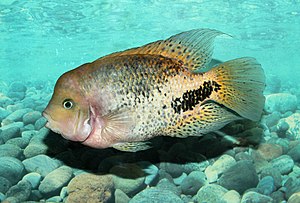Quetzal cichlid
| Quetzal cichlid | ||||||||||||
|---|---|---|---|---|---|---|---|---|---|---|---|---|

Quetzalbuntbarsch ( Vieja melanura ) |
||||||||||||
| Systematics | ||||||||||||
|
||||||||||||
| Scientific name | ||||||||||||
| Vieja melanura | ||||||||||||
| ( Günther , 1862) |
The quetzal cichlid ( Vieja melanura , syn .: Cichlasoma synspilum ), also called fire-headed cichlid , is a large- growing cichlid species that grows on the Caribbean side of Central America in southern Mexico east to the state of Quintana Roo , in northern Guatemala ( Departamento Petén ) and in Occurs in northern Belize. The habitat of the Quetzalb cichlid includes the catchment area of the lower Río Grijalva , large parts of the Usumacinta and the Petén-Itzá Lake and its surroundings.
features
The Quetzalbuntbarsch reaches a length of 30 to 35 cm and has a moderately high-backed, laterally flattened body. The head length makes up 30 to 35% of the standard length and the body height is around 45% of the standard length. The head length is greater than the head height. The mouth is straight and small. It does not extend to the front edge of the eye. The jaw teeth are conical and curved. The teeth on the premaxillary grow larger towards the symphysis . The bases of the dorsal and anal fin and the third to fourth of the caudal fin close to the body are scaled. The tail stalk is higher than it is long. The soft-rayed sections of the dorsal and anal fin are pointed.
- Fins formula : dorsal XVI – XVII / 12, anal VI / 8–9, pectoral 14.
- Dandruff formula : SL 20–21 / 10.
- Vertebrae: 30 (14-15, 15-16).
The color of the Quetzal Cichlid is very variable. Usually the forehead and cheeks are yellowish, throat and chest are reddish. Sometimes the entire head is also colored reddish. The sides of the body are blue-green, the back of the body are often yellowish or orange. A thick, black band, which can also consist of five individual spots, extends over the rear half of the body and reaches down to the tail stalk. There are no clear external differences between the sexes. However, adult males develop a forehead hump with age.
Way of life
The quetzal cichlid lives in the lower reaches of various rivers and lakes and also tolerates slightly brackish water. The fish become sexually mature with a length of 10 cm. They are open brooders who lay their eggs on stones or roots. In a clutch there are usually 300 to 500, at most up to 1000 eggs. The fish form a parent family , with the male having a larger share in defending the territory, while the giving way takes care of the eggs and young fish.
supporting documents
- ↑ a b Morgenstern, R. (2018): Fishes collected by Emanuel Ritter von Friedrichsthal in Central America between 1838–1841 . Vertebrate Zoology, 68 (3): 253-267. Page 257 a. 263.
- ↑ a b Horst Linke, Wolfgang Staek: American Cichlids II, Large cichlids. Tetra-Verlag, Bissendorf 1997, ISBN 3-8974-5101-8 , pages 208-209.
- ↑ Vieja melanura on Fishbase.org (English)